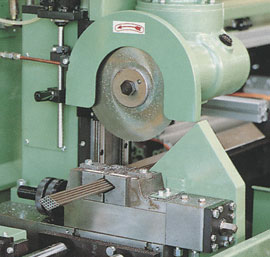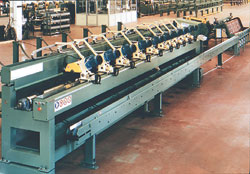- 168#,Yuelu Avenue Steel Industrial Zone, Changsha, China
- 0086-731-88787784
- sales@permanentsteelpipe.com

Which type of tube cutting machinery to use for an operation depends on the tube requirements:
Sawing is one of the most versatile and widely adapted methods for cutting tubing. Each sawing application is unique, but, generally, sawing is suitable for low-volume production.

The most important consideration in sawing is applying the correct blade to the tube to be cut. In all sawing applications, the number of teeth required on the blade is based on the number of teeth that contact the tube on the maximum arc of the cut. Having too few teeth contacting the tube limits production rates and causes vibration. Having too many teeth contacting the tube causes chips to become clogged in the teeth, perhaps causing the teeth or the blade to break.
Two types of sawing machines are used—the cold saw and the band saw.
In principle, cold sawing is the same as turning and milling. Metal is removed by shearing with positive rakes. The basic blade design for cold sawing is a common tooth shape, but others also are used. On thick-walled tubing, specialized bevels are used to break the chip. The cutting zone is cooled to minimize saw tooth softening by lubricating it with soluble oil emulsions or synthetic oil directly in the cutting zone. Flood systems can be used to deliver large quantities of coolant, needed for heavy-wall applications.
The cold sawing process has been adapted to a variety of machines, with varying levels of production capability. A single-head cold saw cuts one tube at a time, although it can cut a bundle of small diameter tubing at once (see Figure 1). Multihead sawing machines can have up to 12 saw heads and cut tubing into multiple pieces.
Cold sawing advantages:

Because the entire kerf loss is milled into chips, scratches and other problems can result during packaging or secondary operations.Cold sawing disadvantages:
Band sawing is suitable for cutting entire bundles of tubing into shorter lengths. It can cut a large bundle, up to 40 by 40 in., of large, heavy-walled square and rectangular tubes into sections. No other method is able to do this as efficiently. However, the tubes have a tendency to drift during bundle-cutting, causing an out-of-square cut. Round tubes may spin during the cutting cycle, so it may be necessary to tack-weld one end of the bundle to prevent the tubes from shifting and spinning. This can be time-consuming and wasteful.
Band sawing has limited usefulness in cutting a single tube, although some special single-head band saws can miter-cut single tubes. It is most suitable for cutting diameters greater than 5 in. OD and heavy-walled sections.
Band sawing advantages:
Band sawing disadvantages:

Because the tube rotates, its length cannot exceed 20 ft. This length limitation can slow production rates.
Another lathe type (rotary lathe) spins a rotary cutting head around a stationary tube (see Figure 3). Up to four cutting tools can be mounted on the rotary head. This type of machine can cut the part and perform internal and external chamfering on it. Optional adapters allow internal and external chamfering on the back side of each part.
Lathe cutting's only application is on round tubes. Typically, it is used to cut high-strength, heavy-walled tubes for components such as bearing liners (52100 steel) and air bag canisters and exotic materials such as titanium and INCOLOY® alloys for components such as automotive axles.
Lathe cutting advantages:
Lathe cutting disadvantages:

Rotary tube cutting has been used in the industry for more than 50 years. Initially it was used in the aluminum tubing industry to cut air-conditioning tubing. As the technology has advanced, its use has expanded to all types of materials and products.
Rotary tube cutting involves parting off round tubing using a cutting blade that rotates around the tube diameter (see Figure 4). The tube is held in position on backup rollers while the rotary cutting blade (wheel) rotates as it cuts into the tube.
Because no kerf or chips are produced by this method, there is no material loss. Instead, the tube material is displaced—pushed toward the face of each side of the cutting blade. This is why a slight angle is produced at the cut end of the tube. Some material is pushed to the tube's ID and a slight amount to the OD, creating a slight bulge on the tube's cut end.
This method is suitable for cutting straight sections of 20- to 25-ft. tubing, or for cutting a coil of tubing, which can be uncoiled and straightened during the cutting process.
The main applications for the rotary method are fabricating aluminum automotive air-conditioning lines, steel automotive fluid transfer lines, copper HVAC components, and, to some extent, general carbon steel components.
The traditional rotary cutting machine tends to distort the tube ID. Technology improvements have been developed to try to improve the cut quality and reduce ID distortion.
Rotary cutting advantages:
Rotary cutting disadvantages:

The shearing sequence begins when a mill length of tubing stock is loaded onto the machine through the external dies of both tooling sections and over both internal punches. A pusher advances the tubing to an adjustable stop finger located behind the movable tooling. The stop finger is adjusted to the cut length. When the tubing hits a stop mechanism or a preprogrammed length, the shearing cycle begins. The material is sheared between the stationary tooling section and the movable tooling section, similar to the cutting action of scissors.The supported shear cutting method was developed in the U.S. more than 50 years ago. A supported shear cutting machine is equipped with two sections of tooling—one stationary and one movable. Each tooling section contains an internal punch and an external die. The stationary tooling section supports the tubing's hollow interior with an internal punch and supports the exterior with a close-fitting external die (see Figure 5).
On some equipment, the movable section moves vertically first and then moves horizontally. On others, the movable section performs an elliptical loop to complete the cut.
At the end of the cutting cycle, the movable section returns to a fixed position, concentric with the stationary section, and the next tube to be cut is advanced. This ejects the cut segment and the process is repeated.
Supported shear cutting advantages:
Supported shear cutting disadvantages:
Blade shearing of tubing has been used for more than 75 years. Dual-blade shear cutting succeeds single-blade shear technology. Dual-blade was developed to eliminate the dimple that typically results on the tube end during single-blade shear cutting.
With this method, the tubing is held in clamping dies. A horizontal blade makes an initial scarfing cut through a portion of the tube wall so that the vertical blade encounters less resistance and pierces the tube wall without dimpling (see introductory photo).
It is most suitable for carbon steels and alloy steels, including ferritic stainless steels.
Each tube diameter requires its own set of clamping dies. The clamping dies are hardened and ground to precise tolerances. They are relatively inexpensive and can be resharpened for use for up to 3 million cuts. Four clamping die sections are assembled into two sections, allowing them to open and close to feed and clamp the tubing and to provide clearance for the horizontal and vertical blades.
During the cutting process, the horizontal blade removes only a small amount of material, but this is necessary to create the notched area for the vertical blade to enter. The initial penetration of the vertical blade directs the slug to the inside of the tube. This slug folds in under the blade and is pushed through the bottom of the tube.
Depending on wall thickness and diameter, the end cut may have some burr and sharp edges.
Dual-blade shear cutting advantages:
Dual-blade shear cutting disadvantages:

The two most widely used laser systems are the carbon dioxide (CO2) and the neodymium suspended in a yttrium aluminum garnet crystal (Nd:YAG).
Lasers are used most often to cut complex tubing parts that require multiple successive procedures such as drilling, punching, milling, sawing, and deburring. Laser cutting enables the complete processing of a part in one operation, on a single machine, using a single tool. Successive secondary operations can be eliminated. Laser cutting is not an efficient method to produce one type of profile, such as only square tubes.
In addition, laser cutting is well-suited for on-demand and small-batch production and when many modifications are needed.
Laser cutting advantages:
Laser cutting disadvantages:
